 |
|
Uniform
Study: 146th New York
by Christopher J.
Daley
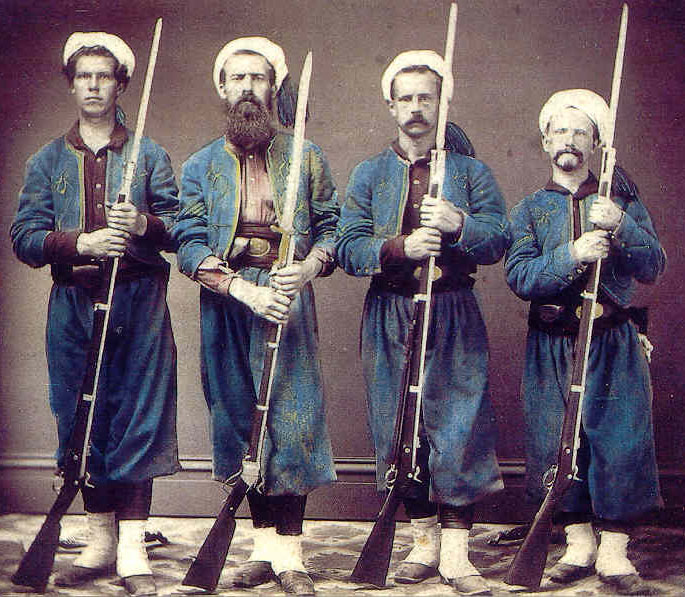 One
of the first units to crest the summit of Little Round Top on July
2, 1863 was the 146th New York Volunteers (Garrard's Tigers). They
did so with brand Zouave new uniforms issued to them a month
earlier on June 3rd. This article will give a brief description of
that uniform. One
of the first units to crest the summit of Little Round Top on July
2, 1863 was the 146th New York Volunteers (Garrard's Tigers). They
did so with brand Zouave new uniforms issued to them a month
earlier on June 3rd. This article will give a brief description of
that uniform.
They
were formed in September of 1862, and were one of the few units to
muster in as a regular volunteer unit, but receive zouave status
mid way though the war. |
|
|
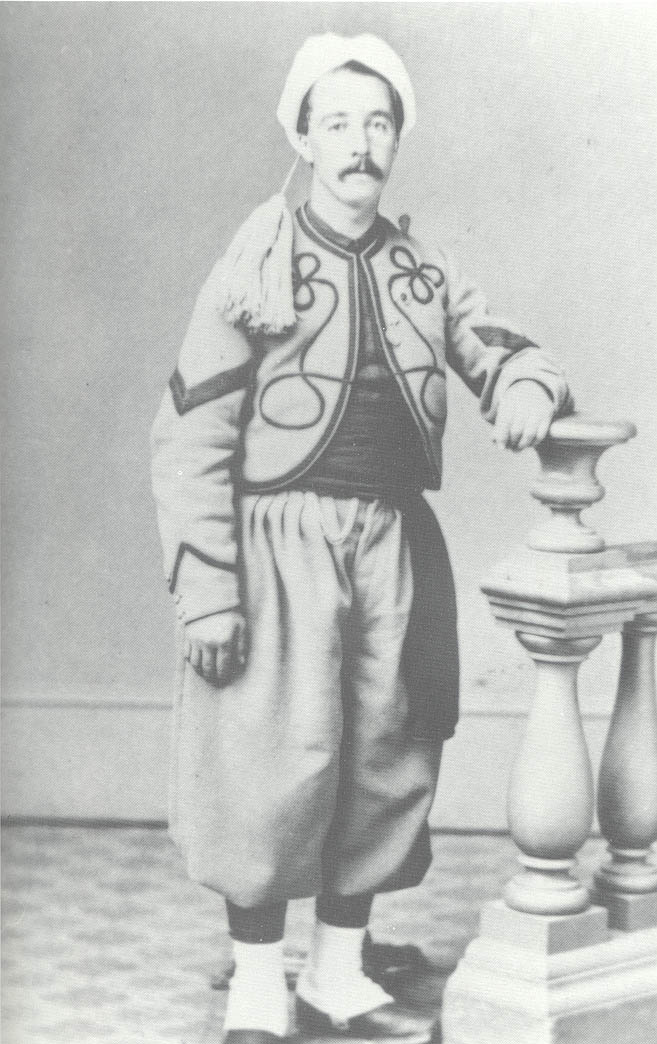 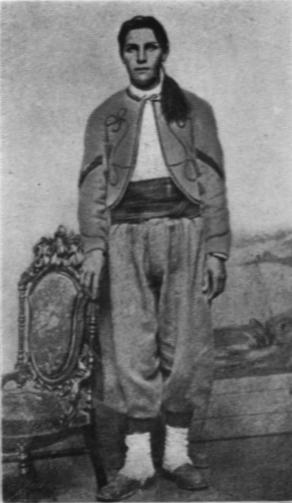 They
were formally brigaded with the 5th New York (Duryee's Zouaves) and
before Chancellorsville 325 of the 5th's veterans were transferred to
fight with the future zouave unit. They
were formally brigaded with the 5th New York (Duryee's Zouaves) and
before Chancellorsville 325 of the 5th's veterans were transferred to
fight with the future zouave unit.
In January 1864, both
the 140th New York and 155th Pennsylvania were also issued distinctive
variations of the Zouave uniform—thus with the 146th, formed the Fifth
Corps’ Zouave Brigade. Later reinforced by the 5th New York Veteran
Zouaves, the colorful brigade stayed together until Appomattox.
-Corporal
Frederick Ernst
146th NYSV "Garrard's Tigers |
|
|
The Influence of the Turcos
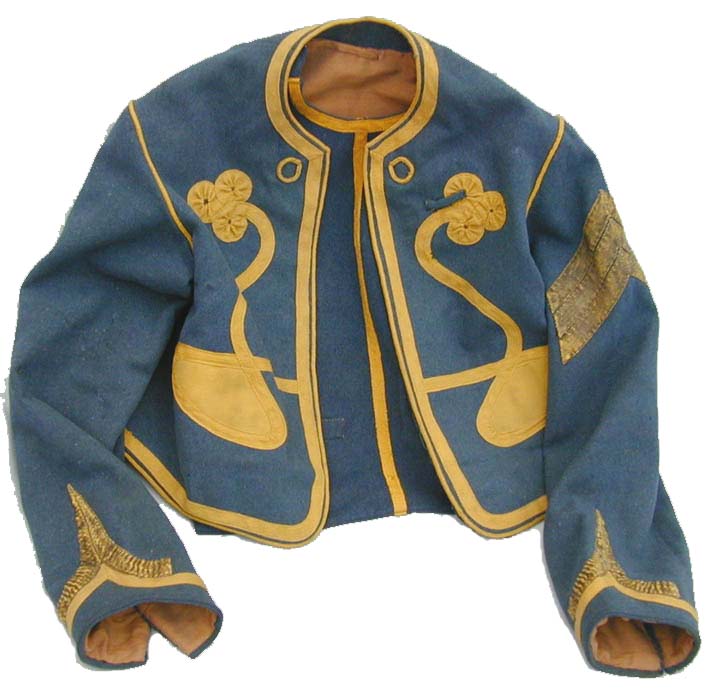 In
the winter of 1863 after receiving the zouave status, the commander of
the 146th NYSV and West Point graduate Colonel Kenner Garrard needed to
come up with a style for his unit's new suit of clothes. In
the winter of 1863 after receiving the zouave status, the commander of
the 146th NYSV and West Point graduate Colonel Kenner Garrard needed to
come up with a style for his unit's new suit of clothes.
While most
zouave units formed during the Civil War based thier uniforms of French
Zouaves with the traditional blue jacket and red pantaloons, Colonel
Garrard had a different design in mind. The new Zouave uniform was based
upon the 'Tirailleurs Algerians' or Turcos of the French army. The
Turcos were native Algerian troops rather than Frenchmen. The uniform
would become one of the most distinctive and recognizable of the war.
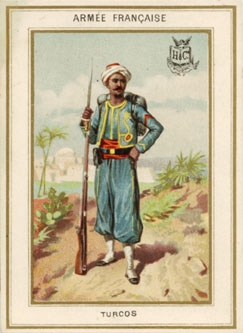 Raised
in Algeria, the Turcos consisted primarily of native Arabic and Turkish
rank and file and NCOs commanded by French officers. They achieved a
reputation as an extremely savage force, often repeatedly hacking at
even dead bodies. Raised
in Algeria, the Turcos consisted primarily of native Arabic and Turkish
rank and file and NCOs commanded by French officers. They achieved a
reputation as an extremely savage force, often repeatedly hacking at
even dead bodies.
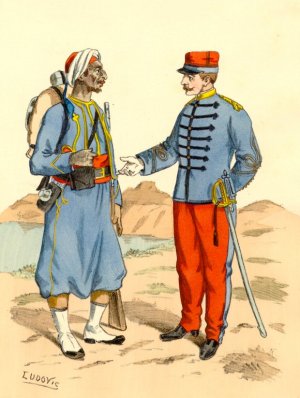 The
Turcos uniform was identical in style to the French Zouaves, but with
the following changes: All the edging and lace is yellow, the false
pockets are red, the sash is red, the fez tassel is sky-blue, and the
pants are sky blue with yellow knot work. Many of the Tirailleurs also
wore white turbans instead of the fez. The
Turcos uniform was identical in style to the French Zouaves, but with
the following changes: All the edging and lace is yellow, the false
pockets are red, the sash is red, the fez tassel is sky-blue, and the
pants are sky blue with yellow knot work. Many of the Tirailleurs also
wore white turbans instead of the fez.
The uniforms
were ordered from the Schuylkill Arsenal and it took 5 months to fill
the order. Colonel Garrard made frequent trips to Washington to
personally supervise the design and production of the uniform. |
|
|
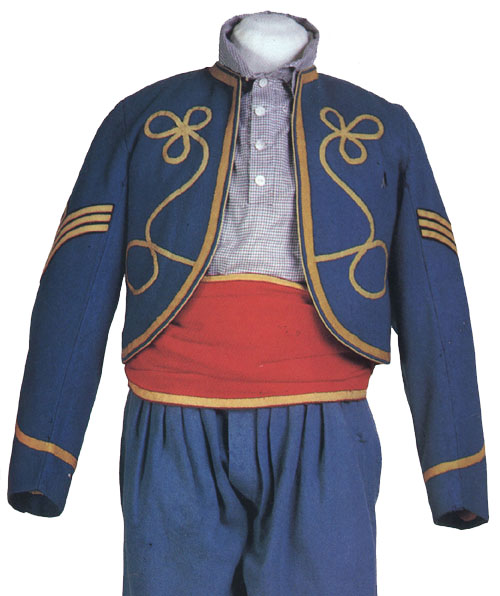 A
detailed study of extant uniforms A
detailed study of extant uniforms
The extant 146th NYSV zouave uniforms
differ in several areas to the Turcos uniforms, but the over all color
scheme is the same; sky blue with yellow trim and a red sash.
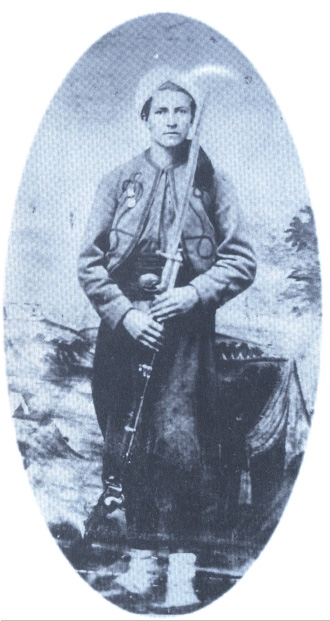 On
November 18, 1994, clothing historians Paul Smith, Joel Bohy and I
examined and photographed the unidentified uniform of a 146th NYSV
soldier on display at the Gettysburg National Military Park Visitor's
Center. Below are the notes and photos taken on that day. All photos
courtesy of Paul Smith (unless otherwise noted). On
November 18, 1994, clothing historians Paul Smith, Joel Bohy and I
examined and photographed the unidentified uniform of a 146th NYSV
soldier on display at the Gettysburg National Military Park Visitor's
Center. Below are the notes and photos taken on that day. All photos
courtesy of Paul Smith (unless otherwise noted).
As typical
with uniforms produced by the Schuylkill Arsenal, the 146th NYSV uniform
is hand sewn throughout. The sky blue jacket and trowsers are made from
twilled wool kersey commonly seen in standard Federal issue trowser and
overcoats. All the braid and lace are wool as is the fez and tassel.
It is
important to note that the shirt, vest, gaiters and brogans displayed on
the mannequin in the Gettysburg National Military Park Visitor's Center
with this uniform are reproductions. There is no evidence that the 146th
NYSV uniform was issued with a vest. |
|
|
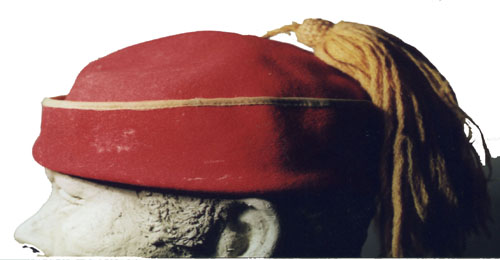 Fez
#1 Gettysburg National Military Park Collection: Fez
#1 Gettysburg National Military Park Collection:
The signature head gear for the zouave is the fez. Unlike the turcos fez
which had a blue tassel, the three extant 146th NYSV fezzes are all
madder red with a yellow wool tassel. The fez is a fine felt and has a
yellow horizontal cotton bias tape hand sewn onto the brim with a
running stitch.
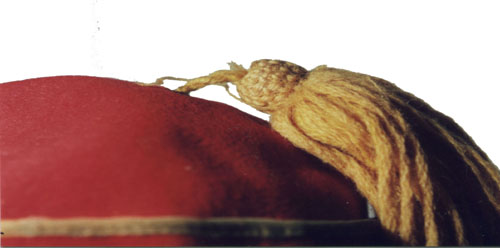 Two
of the three extant fezzes identified as belonging to the 146th NYSV all
have the brims turned up. Two
of the three extant fezzes identified as belonging to the 146th NYSV all
have the brims turned up.
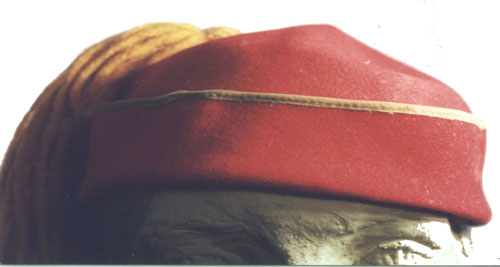 Because
of camera angles and turbins, it is difficult to say how common this
was, but it is known that different zouave units would each adapt a
different style of fez wearing. This could have been the style
chosen by the enlisted men of the 146th NYSV. However, photographic
evidence has only yielded one image of a 146th NYSV soldier with a
turned up brim. The vast majority of the images do show them wearing a
turban, but no extant 146th NYSV turban Because
of camera angles and turbins, it is difficult to say how common this
was, but it is known that different zouave units would each adapt a
different style of fez wearing. This could have been the style
chosen by the enlisted men of the 146th NYSV. However, photographic
evidence has only yielded one image of a 146th NYSV soldier with a
turned up brim. The vast majority of the images do show them wearing a
turban, but no extant 146th NYSV turban |
|
|
Fez #2:
Don Troiani Collection
This second fez is identified to Sergeant James P. Pitcher and has many
of the same features as the first. The tassel has roped yarns and a
macramé cap over the acorn. It is attached by two corded yarns. The brim
is also turned up as in the first example and the yellow trim is cotton.
Unlike the first example, the trim on this fez is applied by machine.
|
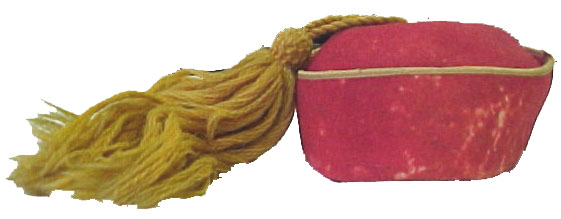 Photo courtesy of Joel Bohy
Photo courtesy of Joel Bohy |
|
|
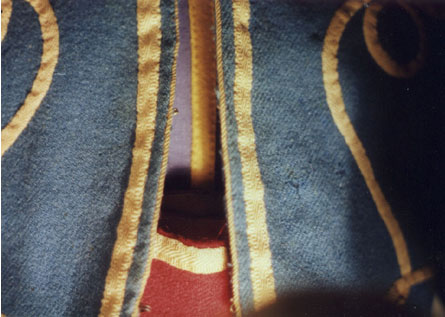 Jacket: Jacket:
The body of
the jacket is cut similar to the Schuylkill Arsenal Zouave pattern seen
in other jackets produced there like the 140th NY and 155th PA. The
jacket has a 6 piece body and a 2 piece sleeve. There are two vents
The
perimeter of the jacket is trimmed with 1/2" yellow worsted wool lace
that is hand set 1/2" from the edge. The stitches are 6-7 stitches per
inch.
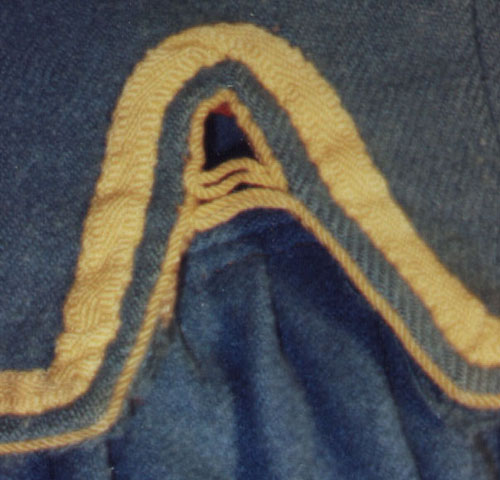 There
are two vents placed in center of the side panel of the jacket. The
vents are 3 1/2" deep and 3 1/2" wide at the bottom. There
are two vents placed in center of the side panel of the jacket. The
vents are 3 1/2" deep and 3 1/2" wide at the bottom.
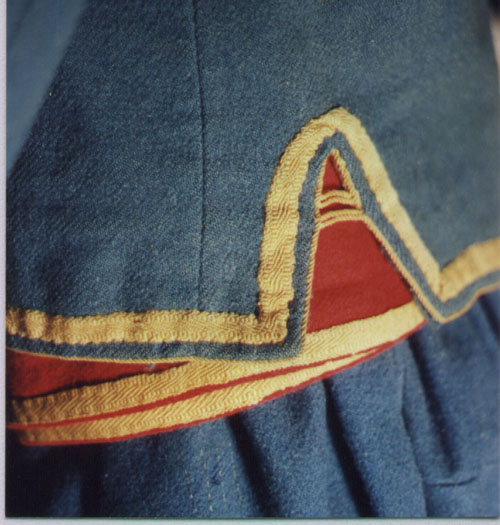 On
the edge of the jacket a 1/8" yellow wool cord has been hand applied.
The cording is in a single strans except for at the vent where there are
two double rows of cording spanning the space at the vent. The first set
is 5/8" down from the peak of the event, the second set it 1/8" down
from the first. On
the edge of the jacket a 1/8" yellow wool cord has been hand applied.
The cording is in a single strans except for at the vent where there are
two double rows of cording spanning the space at the vent. The first set
is 5/8" down from the peak of the event, the second set it 1/8" down
from the first.
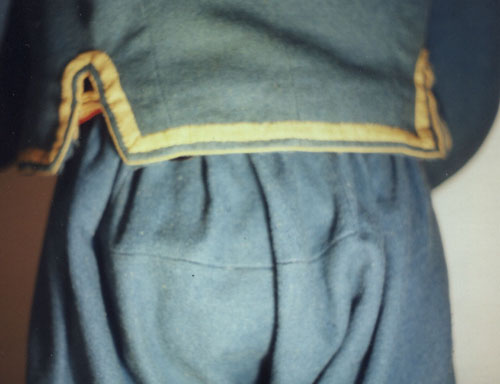 The
jacket is lined with a brown/tan jean cloth. The facing pieces are raw
edged and applied in the typical manner seen in mounted services
jackets, veterans reserve corps jackets and other Schuylkill Arsenal
zouave jackets. The facings are 2 3/4 wide in the front panels and 2"
wide at the bottom of the jacket. The front facing is pieced at the
curve near the bottom. There is no facing at the top of the vent. The
jacket is lined with a brown/tan jean cloth. The facing pieces are raw
edged and applied in the typical manner seen in mounted services
jackets, veterans reserve corps jackets and other Schuylkill Arsenal
zouave jackets. The facings are 2 3/4 wide in the front panels and 2"
wide at the bottom of the jacket. The front facing is pieced at the
curve near the bottom. There is no facing at the top of the vent.
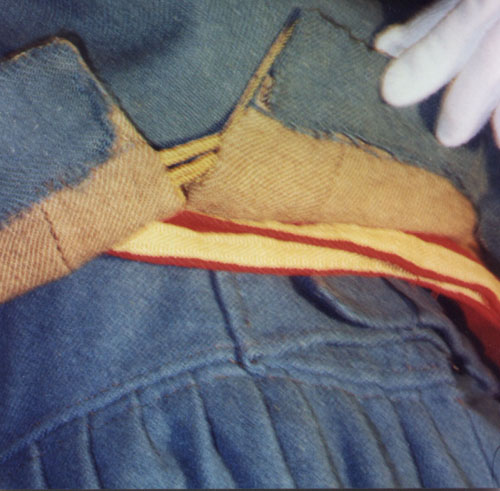 There
is one inside patch pocket made from cotton osnaburg that is 6" deep and
is running stitched into the jacket lining. Three hooks and eyes close
the jacket, while it is believed on the top hook and eye is original to
the jacket, the other sets of hooks and eyes are
spaced
4" between the 1st & 2nd, 5" between the 2nd & 3rd. Below the second
hook and eye, there is a label which reads "Henry
S. White, Walton, N.Y."
it is believed that Henry S. White was not a veteran of the 146th NYSV,
but a costumer who owned the jacket at one point and may have been
responsible for the additional hooks and eyes. There
is one inside patch pocket made from cotton osnaburg that is 6" deep and
is running stitched into the jacket lining. Three hooks and eyes close
the jacket, while it is believed on the top hook and eye is original to
the jacket, the other sets of hooks and eyes are
spaced
4" between the 1st & 2nd, 5" between the 2nd & 3rd. Below the second
hook and eye, there is a label which reads "Henry
S. White, Walton, N.Y."
it is believed that Henry S. White was not a veteran of the 146th NYSV,
but a costumer who owned the jacket at one point and may have been
responsible for the additional hooks and eyes.
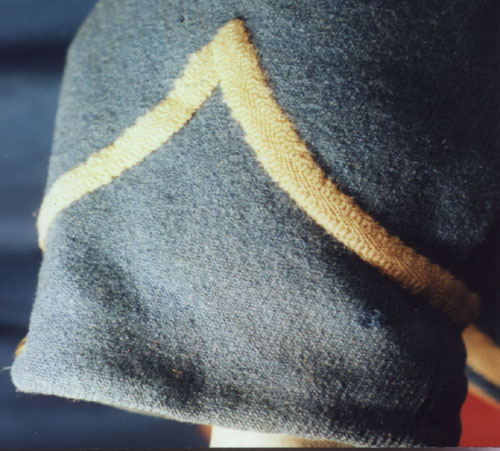 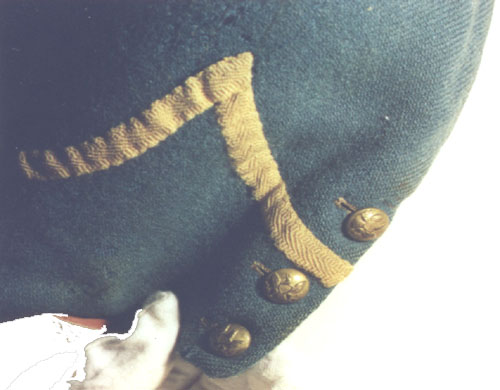 The
sleeve is ballooned and there is a slight easement in the sleeve cap.
The cuff facing is 1" from the finished edge. It isn't raw edged as seen
in Veterans Reserve Corps Jacket, but is turned up as in Mounted
Services Jackets. The
sleeve is ballooned and there is a slight easement in the sleeve cap.
The cuff facing is 1" from the finished edge. It isn't raw edged as seen
in Veterans Reserve Corps Jacket, but is turned up as in Mounted
Services Jackets.
The cuff is
trimmed in a chevron patter with 1/2" yellow worsted wool lace. The lace
is 2" on the in and out seams and rises to 4 1/2". The sleeve lining is
osnaburg and the center back seam is 1 1/4" from the top. The functional
cuff has three cuff sized eagle buttons spaced at 1" from the bottom of
the cuff and 1 1/2" between the second and 3 buttons.
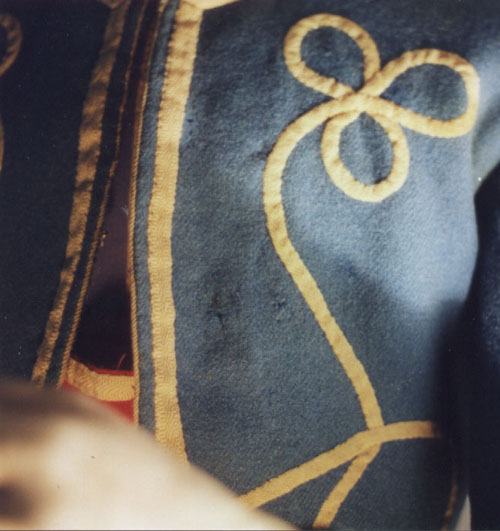 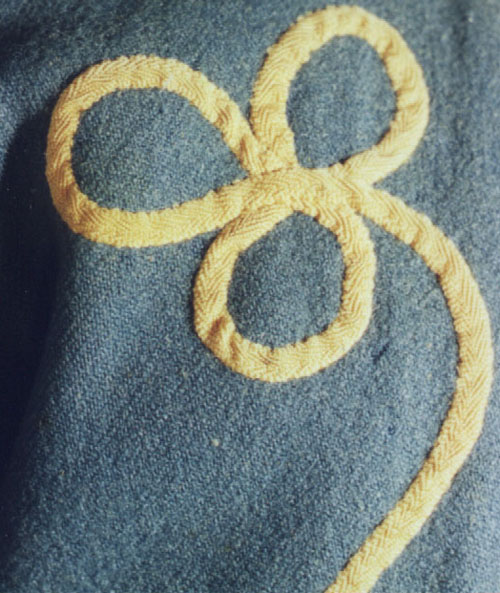 The
tombeaux is centered in the front panels of the jacket and unlike the
Turcos uniform does not have the red false pockets. The lace used is
yellow 3/8" worsted wool and like the rest of the trim on the jacket is
applied by hand. The trefoil at the top of the tombeaux are 1" from
knot, 1 5/8" wide. The
tombeaux is centered in the front panels of the jacket and unlike the
Turcos uniform does not have the red false pockets. The lace used is
yellow 3/8" worsted wool and like the rest of the trim on the jacket is
applied by hand. The trefoil at the top of the tombeaux are 1" from
knot, 1 5/8" wide.
|
|
|
 Sash: Sash:
The sash is
made from a light weight, twilled, madder red wool Flannel. It is 10
feet long. When cut the sash is 25" wide, then folded in half and sewn
with a 1/2" seam to form a 12" wide sash. There is yellow worsted wool
½" lace applied with a running stitch to the perimeter of the sash. The
seam for the sash is under the lace. |
|
|
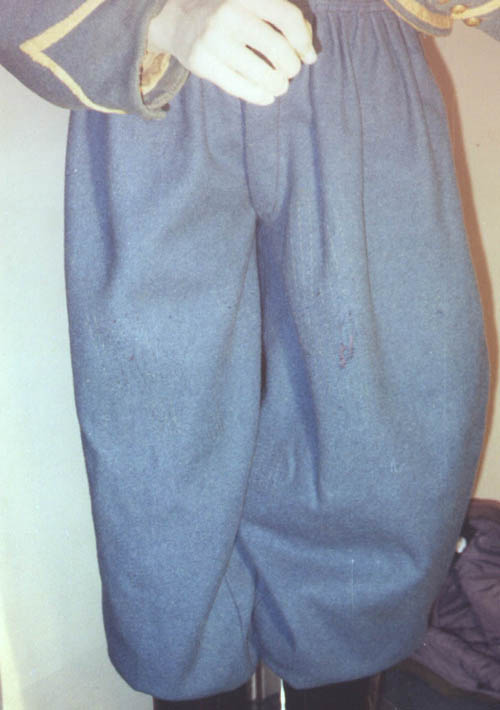 Trowsers: Trowsers:
Unlike
traditional zouave pantaloons which have a low crotch and come to mid
calf, the 146th NYSV were issued chasseur style trowsers.
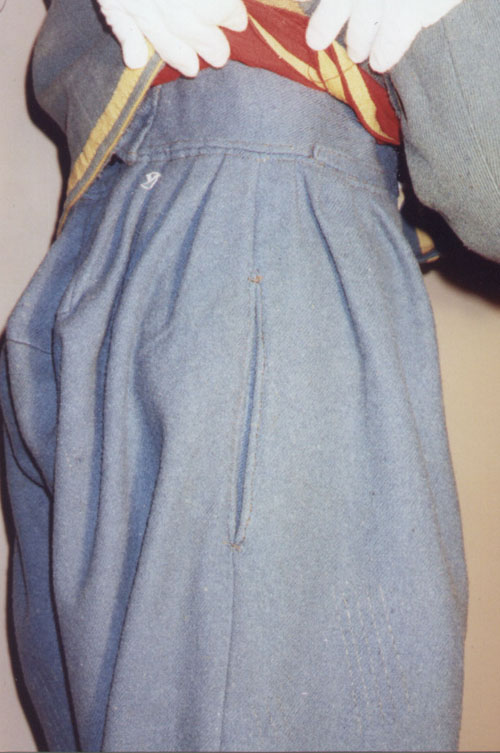
Chasseur
trowsers have many of the same features as pantaloons with a gathered
cuff and pleated front, but the inseam and length are vastly different.
Another
similar feature is the side seam pocket for example which is very
similar to those found on extant zouave pantaloons. The pocket is made
from a crudely woven cotton drilling with fine yarn and they are 10"
deep. Unlike pocket bags found on most traditional trowsers which are
set in the front panel of the trowser, the zouave pocket bag is centered
on the side seam. The center facing is 4" x 8" and the front and rear
facings are 1 3/8" x 8". The pocket is hand topstitched
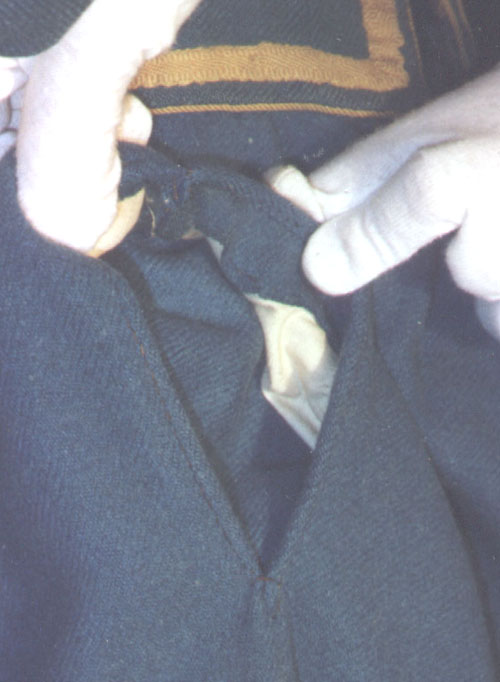 1/4"
from the perimeter of the pocket opening and have reinforcing stitches
at the top and bottom. These trowsers are not trimmed with a corded knot
as seen some zouave trowsers. 1/4"
from the perimeter of the pocket opening and have reinforcing stitches
at the top and bottom. These trowsers are not trimmed with a corded knot
as seen some zouave trowsers.
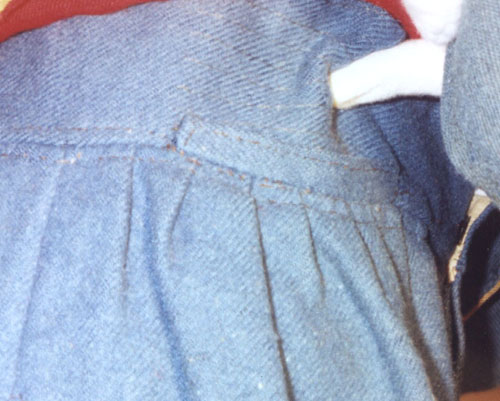 The
watch pocket is 5/8" high and is hand topstitched along the top and
sides as well as underneath the waistband seam. The pocket bag is the
same material as the side seam pockets. The
watch pocket is 5/8" high and is hand topstitched along the top and
sides as well as underneath the waistband seam. The pocket bag is the
same material as the side seam pockets.
The
waistband is wider than other zouave trowsers and is 2 5/8" in front and
3½" in rear. Rounded waistband is rounded in the rear above the vent.
The waistband lining is cotton drill and is the same as the pockets.
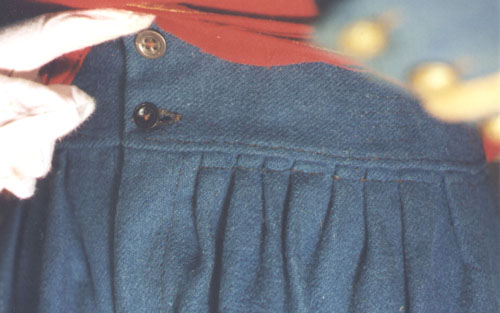 There
is one 1" buttonholes that are 5/8" from bottom of band and 3/8" from
edge. The button is japanned tin. The paperbacked tin button above waist
band button is non-functional and while it was intended to be buttoned
to a vest, there are no known records of vest being issued to the unit. There
is one 1" buttonholes that are 5/8" from bottom of band and 3/8" from
edge. The button is japanned tin. The paperbacked tin button above waist
band button is non-functional and while it was intended to be buttoned
to a vest, there are no known records of vest being issued to the unit.
The trowsers
are baggy and are gathered into the waistband using pleats. There are 8
¾"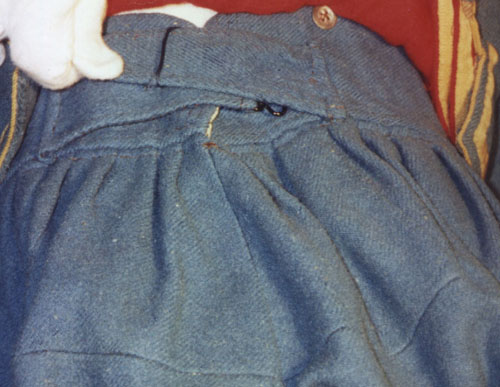 accordion pleats across the rear and 8 ¾" accordion pleat front. They
are hand topstitched ¾" to 3/8" variable below the waistband and are
hand topstitched ¼" above waistband
accordion pleats across the rear and 8 ¾" accordion pleat front. They
are hand topstitched ¾" to 3/8" variable below the waistband and are
hand topstitched ¼" above waistband
There is a
pentagon shaped yoke in the rear of the trowsers and a bar tack
reinforcing the bottom of the vent. There is a back belt used to adjust
the fit of the trowsers above the hips it is is 2 5/8" wide in the rear
and tapers to 1 1/8" in the front, It is backed with blue polished
cotton and is pieced. It is hand felled & topstitched ¼" from edge.
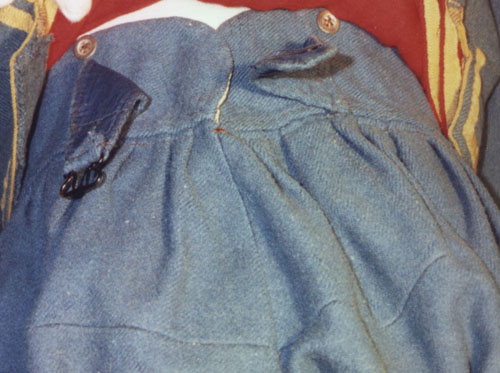
The fly is
also lined with Blue polished fly lining like the back belts. The fly is
topstitching 1¼" from edge on fly lining. There is a row of
topstitching on bottom of the fly. First row is 5/8" from bottom, second
row is ¼" above that.
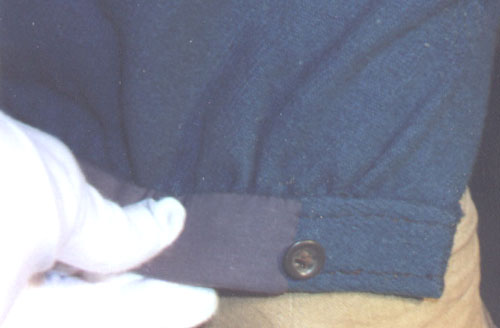 The
trowsers do taper slightly and gather into a functional cuff which
fastens with a button. The
trowsers do taper slightly and gather into a functional cuff which
fastens with a button.
Overall the
uniform is very well made and offers a fine example of the craftsmanship
and skill level of the Schuylkill Arsenal. |
|
|
In the
future, other 146th NYSV identified uniforms will be examined. The notes
and photos of those uniform items will be published on this page. If
anyone has questions or comments about this uniform or primary source
documentation about the 146th NYSV, I would appreciate you contacting
me.
tailor@cjdaley.com
|
|
|
ACKNOWLEDGMENTS:
I would like to thank Paul Smith, Joel Bohy, and Don Troiani for their
help with this uniform study. Unless otherwise noted, all photos were
taken by Paul Smith. |
|
  |



